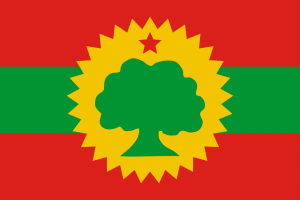Language/Borana-arsi-guji-oromo/Grammar/Singular-and-Plural-Nouns
| ◀️ Traditional Music and Dance — Previous Lesson | Next Lesson — Personal Pronouns ▶️ |
Borana-Arsi-Guji Oromo nouns are words used to name persons, animals, objects, places, and ideas. In this lesson, you will learn how to form singular and plural nouns in Borana-Arsi-Guji Oromo and recognize their gender.
Gender in Borana-Arsi-Guji Oromo
Like many languages, Borana-Arsi-Guji Oromo has a system of noun classification, known as grammatical gender. However, unlike many other languages, Borana-Arsi-Guji Oromo has only two genders: masculine (jibicha) and feminine (dhibaatee).
Nouns denoting male humans, male animals, and some natural elements are generally classified as masculine, while nouns denoting female humans, female animals, and some natural elements are classified as feminine. Gender is important in Borana-Arsi-Guji Oromo grammar because it affects the formation of singular and plural nouns, as well as the agreement of adjectives and verbs with the nouns they modify or refer to.
Formation of Singular Nouns
In Borana-Arsi-Guji Oromo, most nouns are formed by adding a suffix to a root word. The most common suffixes are "-ttii" for masculine singular nouns and "-ttiin" for feminine singular nouns. For example:
| Borana-Arsi-Guji Oromo | Pronunciation | English |
|---|---|---|
| garaa | gər-aa | ox (masculine) |
| garaattii | gər-aa-ttii | ox (singular) |
| qaboo | qa-b-oo | cow (feminine) |
| qaboottiin | qa-b-oo-ttiin | cow (singular) |
Note that the suffix "-aa" in the root word "garaa" means "ox" and is not part of the suffix for the singular noun.
In some cases, the root word may change slightly before the suffix is added. For example:
| Borana-Arsi-Guji Oromo | Pronunciation | English |
|---|---|---|
| qalqala | qal-qal-a | key (feminine) |
| qalqaltiin | qal-qal-tiin | key (singular) |
Here, the final vowel of the root word "qalqala" changes to "-t" before the suffix "-tiin" is added.
Formation of Plural Nouns
In Borana-Arsi-Guji Oromo, plural nouns are generally formed by adding the suffix "-tii" or "-tiin" to the singular noun, depending on its gender. For example:
| Borana-Arsi-Guji Oromo | Pronunciation | English |
|---|---|---|
| garaattii | gər-aa-ttii | ox (singular) |
| garaattii-tii | gər-aa-ttii-tii | oxen (masculine) |
| qaboottiin | qa-b-oo-ttiin | cow (singular) |
| qaboottiin-tii | qa-b-oo-ttiin-tii | cows (feminine) |
Note that the plural suffix does not change depending on the gender of the noun; it always ends in "-tii" or "-tiin".
In some cases, the root word may change slightly before the plural suffix is added. For example:
| Borana-Arsi-Guji Oromo | Pronunciation | English |
|---|---|---|
| qalqaltiin | qal-qal-tiin | key (singular) |
| qalqaltiin-tii | qal-qal-tiin-tii | keys (feminine) |
Here, the final consonant "t" of the root word "qalqal" is doubled to "-tt" before the plural suffix "-tii" is added.
Exceptions and Irregularities
Like most aspects of natural language, the formation of Borana-Arsi-Guji Oromo singular and plural nouns is not entirely predictable. There are some exceptions and irregularities in the formation of specific nouns, which must be learned by rote. Here are some examples:
| Borana-Arsi-Guji Oromo | Pronunciation | English |
|---|---|---|
| dhugaa | dhug-aa | donkey (masculine) |
| dhugaaya | dhug-aaya | donkeys (masculine) |
| hiyyoo | hi-yoo | egg (feminine) |
| hiiyittiin | hi-yi-ttiin | eggs (feminine) |
As you can see, the plural of "dhugaa" is formed irregularly by changing the final vowel to "-aaya", while the plural of "hiyyoo" changes the final "o" to "i" before adding the plural suffix.
Summary
In this lesson, you learned how to form singular and plural nouns in Borana-Arsi-Guji Oromo and recognize their gender. You also learned that gender is an important aspect of Borana-Arsi-Guji Oromo grammar, affecting the agreement of adjectives and verbs with the nouns they modify or refer to. While there are some exceptions and irregularities in the formation of specific nouns, the basic rules and patterns for forming singular and plural nouns can be applied to most nouns in the language.
Other Lessons
- Personal Pronouns
- Negation
- Questions
- Alphabet and Pronunciation
- Give your Opinion
- Present Tense
- Pronouns
- Adjectives
- 0 to A1 Course
Template:Borana-arsi-guji-oromo-Page-Bottom
| ◀️ Traditional Music and Dance — Previous Lesson | Next Lesson — Personal Pronouns ▶️ |

